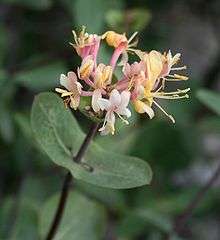Lonicera etrusca
Lonicera etrusca is a species of honeysuckle known by the common name Etruscan honeysuckle.[2][3] It is native to Europe and it is known elsewhere, including the Pacific Northwest of North America, as an introduced species where it has escaped cultivation. It is kept in gardens as an ornamental plant.
| Lonicera etrusca | |
|---|---|
 | |
| Scientific classification | |
| Kingdom: | Plantae |
| Clade: | Tracheophytes |
| Clade: | Angiosperms |
| Clade: | Eudicots |
| Clade: | Asterids |
| Order: | Dipsacales |
| Family: | Caprifoliaceae |
| Genus: | Lonicera |
| Species: | L. etrusca |
| Binomial name | |
| Lonicera etrusca Santi | |
| Synonyms[1] | |
| |
Description
This is a deciduous perennial climber which can reach lengths of 6 meters. It is lined with oval leaves several centimeters long and bears dense spikes of flowers with pairs of fused leaves at the bases. Each flower has an elongated tubular corolla up to 5 centimeters long divided partway into two lips. The flower is light yellow to pale reddish-pink. The stamens and style protrude from the flower's mouth. The fruit is a bright red rounded berry.
Cultivars
Notable cultivars include 'Donald Waterer'[4] and 'Superba'.[5] The latter has gained the Royal Horticultural Society's Award of Garden Merit.[6] It bears fragrant cream-coloured flowers, which age to yellow.
Other Uses
In addition to the plant being grown as an ornamental, the leaves and flowers of L. etrusca var. etrusca are used as fodder on Mount Honaz and in its vicinity in the Denizli Province of Turkey.[7]
Toxicity
The berries are poisonous.[8]
References
- "The Plant List: A Working List of All Plant Species". Retrieved 7 December 2014.
- "BSBI List 2007". Botanical Society of Britain and Ireland. Archived from the original (xls) on 2014-10-23. Retrieved 2014-10-17.
- "Lonicera etrusca". Natural Resources Conservation Service PLANTS Database. USDA. Retrieved 26 January 2016.
- "RHS Plant Selector - Lonicera etrusca 'Donald Waterer'". Retrieved 22 May 2013.
- "RHS Plant Selector - Lonicera etrusca 'Superba'". Retrieved 22 May 2013.
- "AGM Plants - Ornamental" (PDF). Royal Horticultural Society. July 2017. p. 61. Retrieved 28 March 2018.
- https://www.researchgate.net/profile/Muhsin_Konuk/publication/225749741_An_Ethnobotanical_Survey_of_Inner-West_Anatolia_Turkey/links/0c960528d329b835d7000000/An-Ethnobotanical-Survey-of-Inner-West-Anatolia-Turkey.pdf?origin=publication_detail Kargıoğlu,Mustafa, Cenkci,Süleyman, Serteser,Ahmet, Konuk,Muhsin and Vural,GürselTraditional Uses of Wild Plants in the Middle Aegean Region of Turkey Human Ecology, Volume 38, Number 3, 2010. Retrieved 10.52 on 6 May 2018.
- https://www.botanical-online.com/english/honeysuckle-species.htm Retrieved 9.23 6 May 2018.